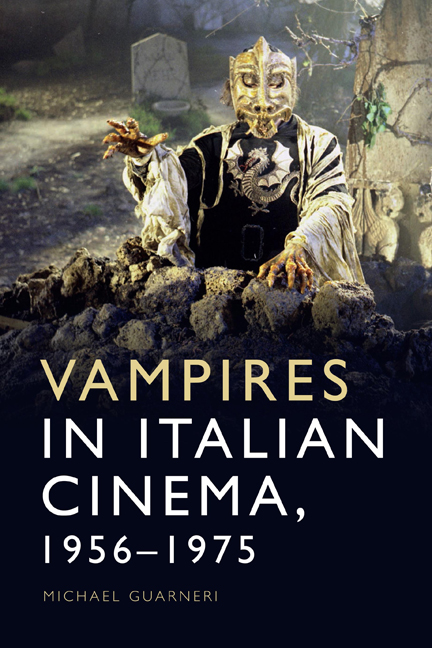Book contents
- Frontmatter
- Contents
- Figures and tables
- Acknowledgements
- Introduction
- PART I THE INDUSTRIAL CONTEXT
- PART II VAMPIRE SEX AND VAMPIRE GENDER
- PART III SANGUINE ECONOMY, BLOODY POLITIC
- Appendix A Three Italian vampire films that were never made
- Appendix B Files from the Italian Show Business Bureau fonds at the Archivio Centrale dello Stato in Rome
- Bibliography
- Index
2 - Italian vampire cinema (1956–1975)
Published online by Cambridge University Press: 10 October 2020
- Frontmatter
- Contents
- Figures and tables
- Acknowledgements
- Introduction
- PART I THE INDUSTRIAL CONTEXT
- PART II VAMPIRE SEX AND VAMPIRE GENDER
- PART III SANGUINE ECONOMY, BLOODY POLITIC
- Appendix A Three Italian vampire films that were never made
- Appendix B Files from the Italian Show Business Bureau fonds at the Archivio Centrale dello Stato in Rome
- Bibliography
- Index
Summary
THE MARK OF THE HAMMER DRACULA
November–December 1956 saw the shooting of Riccardo Freda's I vampiri and Hammer's The Curse of Frankenstein (Terence Fisher, 1957), with the Italian release of the former in April 1957 pre-dating by a month the British release of the latter. October–November 1957 saw the Mexican release of El vampiro (Fernando Mendez, 1957), produced by Mexican actor Abel Salazar to exploit the domestic success of Frankensteinian rip-off Ladrón de cadáveres / The Body Snatcher (Fernando Mendez, 1956), and the shooting of El ataúd delm vampiro (Fernando Mendez, 1958) and the Hammer Dracula. Meanwhile, in the US, Universal's pre-1948 horrors began to be broadcast to syndicated TV by Columbia in a highly successful package known as Shock Theater (Clarens 1968: 171–2). For these reasons, 1956 and 1957 are seen as the landmark years of a ‘Gothic revival’ that involved Italian and Mexican film production companies, Hammer and its Hollywood silent partners Warner Bros., Universal and Columbia, soon joined by American International Pictures, which inaugurated its Edgar Allan Poe cycle in 1959–1960 with The Fall of the House of Usher (Roger Corman, 1960) (Worland 2014). Contrary to the Mexican and Anglo- American film industries, churning out horror movies on an assembly-line basis ever since 1956–1957 (Heffernan 2004: 43–62, 90–112; Meikle 2009: 25–116; Vitali 2016: 77–120), the Italian film industry did not immediately join the trend: lacking a horror-hungry national audience and the international perspectives opened up by Pietro Francisci's peplum Le fatiche di Ercole in 1958, I vampiri remained an isolated incident for more than two years, to the point that, as the Italian film press of the early 1960s (Anonymous 1960c and 1960f; Fofi 1963) and all horror scholars from Mora (1978) to Di Chiara (2016b) remark, it is more appropriate to consider Fisher's Dracula as the actual progenitor of Italian horror cinema.
The Hammer Dracula's co-financier and worldwide distributor Universal submitted the movie to the Italian Film Censorship Office on 7 November 1958, under the title Dracula il vampiro. The censorship commission reviewed the film on the very same day (which was quite unusual given the government officials’ busy schedules) and denied it the public-screening permission ‘because the movie contains scenes, events and sequences that are truce, repugnant and shocking’ (Nullaosta 28085 1958).
- Type
- Chapter
- Information
- Vampires in Italian Cinema, 1956-1975 , pp. 41 - 74Publisher: Edinburgh University PressPrint publication year: 2020



